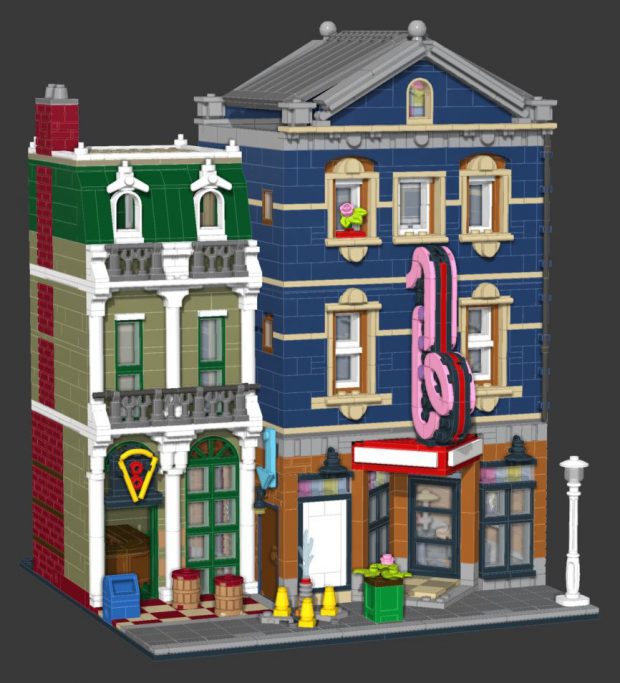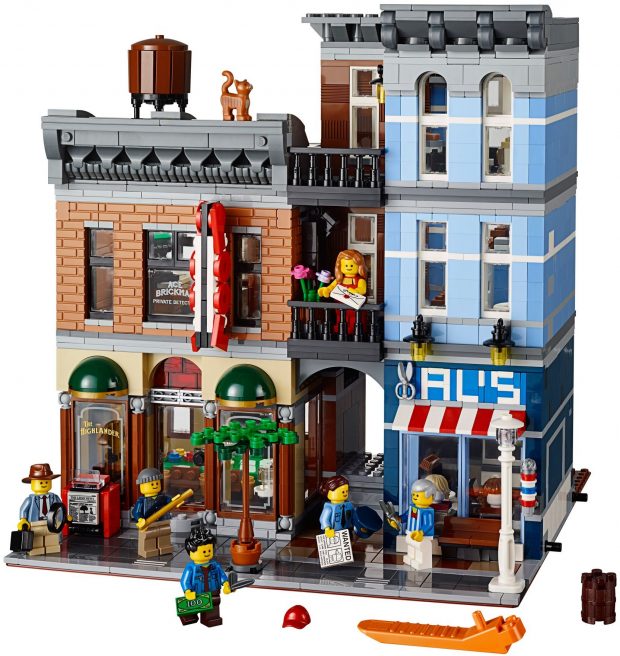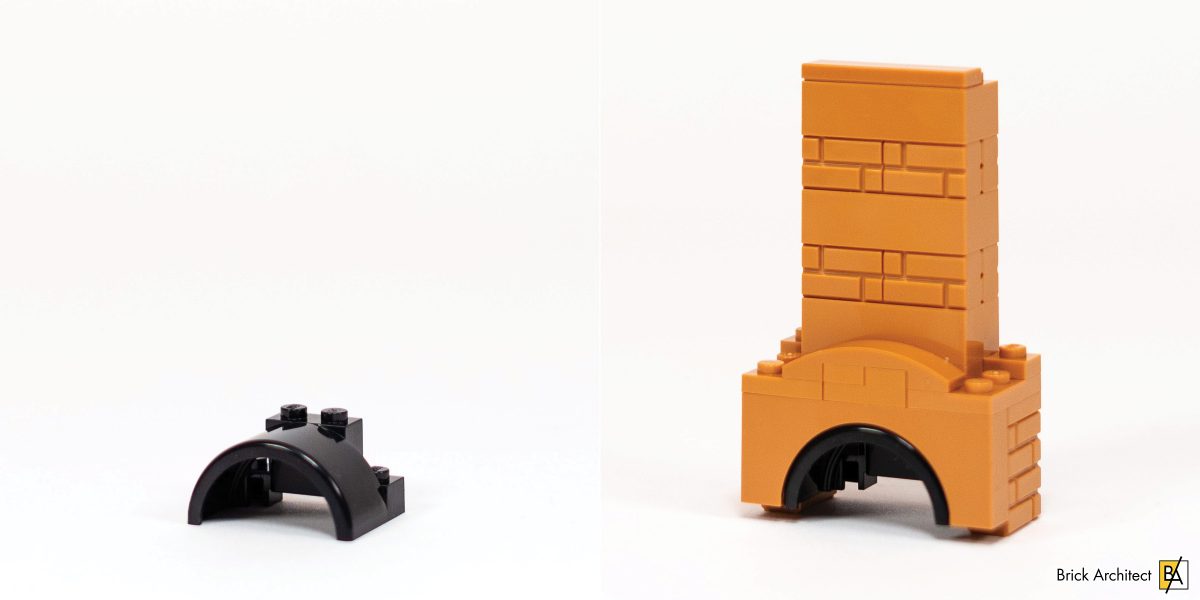Interview: Backstage Tour of #10312 Jazz Club with Jamie Berard
For the second year in a row, I had an opportunity to interview the team responsible for the latest addition to the Modular Building Series.
Read the Review first!
Before reading this interview, I suggest that you take a few minutes to read our in-depth review #10312 Jazz Club. Re-familiarizing yourself with the set will make this interview a lot more interesting.
While the interview responses were by Jamie Berard, you will find a few design explorations throughout the article which were provided by set designer Anderson Ward Grubb.
Designing #10312 Jazz Club
Question: During the development of the Jazz Club, what was the first thing that captured your imagination?
Jamie Berard: When Andy started experimenting with the corner door approach with the awning, it started to feel very fresh but also reminiscent of a fine tradition in the past where we’ve tried to explore doorways and openings and putting things in angles. I also really appreciated … fully developing the stories and the characters; the fact that he actually gives each of the characters a place in the model that you look forward to seeing them in that place. He’s [also] had a lot of fun bringing in animals.

Early facade explorations showing different marquees and architectural details. (Photo: Anderson Ward Grubb / The LEGO Group.)
Question: When we talked with Andy last year, he expressed that he would probably have to do something ‘boring’ this year after getting to work on the Boutique Hotel. Why did he get a second chance in a row?
Jamie Berard: When somebody like Andy does something as mind-blowing as the Boutique Hotel, which for me is just really amazing, you can’t help but keep them close and say we would love to have you come back and revisit it. When you do get a chance to do a second one, you have the advantage of having done the first one. You get that head start, [and] you’ve built that network. As people are just leaving things on your desk and prompting ideas, you can’t possibly fit all of them into one model. So it is kind of a gift when you get a chance to do a second one.
It’s one of the product lines that we have a group of people that are anxious to get on the project … if ever the timing works out, I would love to do that. Unfortunately, a lot of it is timing … when Mike Psaki is working on a Titanic, he’s full and when that Titanic’s done, he’s free to do the next one. … We have that short list of people that we know are particularly good at modular buildings or have a vision for it.

A later design exploration showing similar architectural details on the facade, but a brick-built saxophone on the marquee. (Photo: Anderson Ward Grubb / The LEGO Group.)
Question: When did you decide to make it a Jazz Club, and were other musical styles considered?
Jamie Berard: On this one, it was Jazz the whole way through. I could say quite candidly that the LEGO Ideas set was already happening, [which] got a lot of people really excited about … other stories we can tell. It also gave us an opportunity to, introduce new wigs and outfits and stage setting. I think it was on his mind even before the LEGO Ideas Jazz Club, but that just further reinforced his energy that we should do this.
Question: There are some compositional similarities between this set and #10246 Detective’s Office. Was that intentional?
Jamie Berard: I could definitely see that comparison … it speaks to some of the storytelling that was happening during its development. I think there’s something about that film noir time period of mystery and ‘evening stories’. It was a deliberate choice … when you’re at a hotel you want to have a night out. We don’t have very many activities … You can go to the cinema, and now you can go to the Jazz Club. Once you start to think evening stories you start to think [about] neat smoky rooms with ambiance and a little bit of a grittier [story]. .. It all kind of plays into a feel matching with the Detectives office where [they are] trying to find a cookie smuggler, just listening to that beat in his head while he’s trying to solve the case.
I think there’s also a very deliberate link to the Assembly Square, maybe not architecturally but thematically. We’ve had a celebration of music in many of our modular buildings, and then to be able to have the music shop in the Assembly square, and then you got the jazz poster and the hotel, it’s all kind of building to that type of feel.
I think there’s something about that film noir time period of mystery and ‘evening stories’.
Jamie Berard
Parts used in this set
Question: Was the new mudguard element used in the Pizza oven requested by another team?
Jamie Berard: It’s definitely from another team. We’re struggling with so many new elements, but we’re trying to make more versatile elements that can be used in many places. So I think that generic shape that you’re seeing that we can use as a pizza oven is a very deliberate attempt at trying to create more of these core elements that can be used for anything
Question: How do you decide on the baseplate color for the Modular Buildings?
Jamie Berard: It is at the discretion of the designer. They get a limited number of [new] colors … and for some [designers] getting additional baseplate colors is appealing. … There is sometimes a strategic advantage, like for the palace cinema, we made it in red because we wanted the nice red floor on the inside and then by having the base plate you don’t have to tile it. [This model has] full tiling, so I think it was just a chance to get a nice color baseplate out there when no one else is really able to make base plates anymore…. I think we’re one of the last groups.
Question: Why did you introduce a new ‘Margherita’ pizza print?
Jamie Berard: [We] have tried to get in the habit of just intentionally letting some decorations exit just to make sure that they don’t get overused. In the design organization, we have a habit of holding on to things for quite a while just because they’re available. But something like pizza, there’s so many varieties of pizza… So the choice was made that that one exited, and then it was a choice of who wants to make the new next pizza slice. And I have to say it was a quite a fun journey to go on in a team filled with a mix of vegetarians and meat lovers. So we did land on the delicious basil and mozzarella, but anticipate that hopefully that means in the future new toppings and flavors might be coming out.
Jamie also shared that: “I do like a bit of pineapple on my pizza… to the point that when I call the pizzeria in town, they already know my order. It’s the pineapple, chicken, and mushroom pizza.”
More like this?

Subscribe to the Brick Architect newsletter for early access to exclusive content, the latest articles, and updates to the Printable LEGO Brick Labels, LEGO Storage Guide, and my book The LEGO Architect.
The Modular Building Series
Question: What has surprised you about how the [modular building] collection has evolved in the past few years?
Jamie Berard: what I can say is probably surprised me the most is just how some of the things that excited people in the very early buildings are still very present today … it [is] really fun and easy to tap into previous stories and build new stories because the foundation of everything is just so open.
The biggest surprise for me is that we still after all these years, have so many more stories to tell, so many more styles of architecture, so many more building techniques. It gives me optimism that we’ve got a long future ahead.
Question: Does the team have a list of possible options for modular buildings, and it’s just a case of trying to arrange future sets in the right order?
Jamie Berard: We used to have more of a deliberate order of things that we wanted to launch, but we’re at the point now that we we have more of a general guideline of where we want to go with with this story and [how] all of these stories should coincide. … I’ve always kind of liked the idea this is one universe all at once [which] leaves a lot of latitude to make relationships cross the buildings. … By by no means do we have the next 12 modulars lined up that this is what we’re doing.
You start to see things that we have planted in other modular buildings maybe could be supported [in the future]. For example, we put a poster in for the hotel that leaves the door open to follow-up on that story. But we also have hundreds of stories that are little prompts in all of the previous buildings that could be followed up on, but I think it’s more trying to capture. … We’re almost like town planners. We’re trying to fill out a happy population where we get NPS scores and people say we’ll vote for that mayor again because the towns looking good. We kind of view it that way.
As a building experience, [we are looking for] new techniques we can offer using clever elements, architecture [styles that] allow us to take advantage of new pieces that are coming out, and new colors in the palette that we’re just dying to use.
By by no means do we have the next 12 modulars lined up.
Jamie Berard
Question: Given economic uncertainty, have you considered doing a 16-stud wide modular?
Jamie Berard: It’s a great question because [it] goes back 15 years… what is the right modular? When we did Market Street, the intention was that we would actually vary anywhere from 1/2 building all the way to an Assembly Square or even go to bigger. The 32 by 32 just works really well for most people and has proven to be the right level … It still isn’t a lot of money to ask for most people, but it allows us to fully do the concept that you can actually get all of the details and the stories.
When you go to a half base plate it gets fairly tight for adult hands and so you really have to it limits how much you can change the form and things that you can do. … we did do that with the pet shop. That was our attempt to give you that half building that you could split and mix, but you still got two half buildings in the same set. It was a bit of a compromise, but I think with that model you can already see the interior space can only do so much before you hit that. I’m not discounting that there is a value to the other sizes. We just want to use them strategically when there’s that extra special story that just warrants a bigger footprint or a smaller footprint.
Question: If management allowed you to build a 6000-piece set, do you have ideas about what you would want to build?
Jamie Berard: I instantly have a half a dozen [ideas], but that’s without any conversation with other people. To have higher price points, there’s so much more you can do. There’s definitely some things that we can do masterfully at a bigger size. The problem is people have to be able to afford it and put it somewhere.
Higher price points exclude a certain audience of people. When it’s a collectible line that a lot of people buy into religiously, we have to be very careful that we don’t create that one unattainable something that makes people feel incomplete. So as much as I would love to do it, I think we would really have to think carefully about how we would make that accessible enough while still celebrating its grand scale.
To have higher price points, there’s so much more you can do. The problem is people have to be able to afford it and put it somewhere.
Jamie Berard
Question: As the project manager, how do you balance consistency within the theme and creative freedom for the current designer?
Jamie Berard: I’m really trying to leave enough space that nobody feels it’s been scripted and there’s just an order that they have to follow. I really love the idea of everyone coming on to the project. They’re all passionate about it and have a view of something that the street needs, and I would love to hear it. Then we just try to guide them to make sure they adhere to some of those principles that really make people come back again and again.
Question: When choosing minifigures for each set, how much backstory do you imagine for each character? Do they have names which are used during the development process?
Jamie Berard: [We had] too much fun actually giving character names during the detectives office … the detective was ‘Ace Brickman’. And then we got feedback from the fan community [that we] don’t need to be that explicit … telling me where to move cookies and giving names to the characters.
The whole idea of this street is supposed to be open-ended creativity… every character can be who they want to be. Especially in the two dots smileyface era, they are very ambiguous… Is it a man? Is it a woman? It can really be who you want it to be. I’ve grown to appreciate that part of the charm is not being too prescriptive.
Question: With so many more sets in recent years aimed at AFOLs, does that put more pressure on the modular team?
Jamie Berard: I have to say I’m a big fan of competition that I really love. I love us to never get complacent. I love the idea that there’s always somebody trying to outdo us, [although] honestly, the fan community has been there all along.
As disruptive as it is and uncomfortable as it may be, I love it. It really makes for the best products … you’ll find there are some products that maybe you don’t connect, and maybe weren’t our best hit, but it was an opportunity to try something. Having more products, you can experiment more and then learn from them and then hopefully get better and better. If you only have 4 products, you’re not going to take too many leaps of faith because they all have to work. If you have a bigger assortment, you’re more likely to try things because you have that opportunity to stand out or just do something different.




